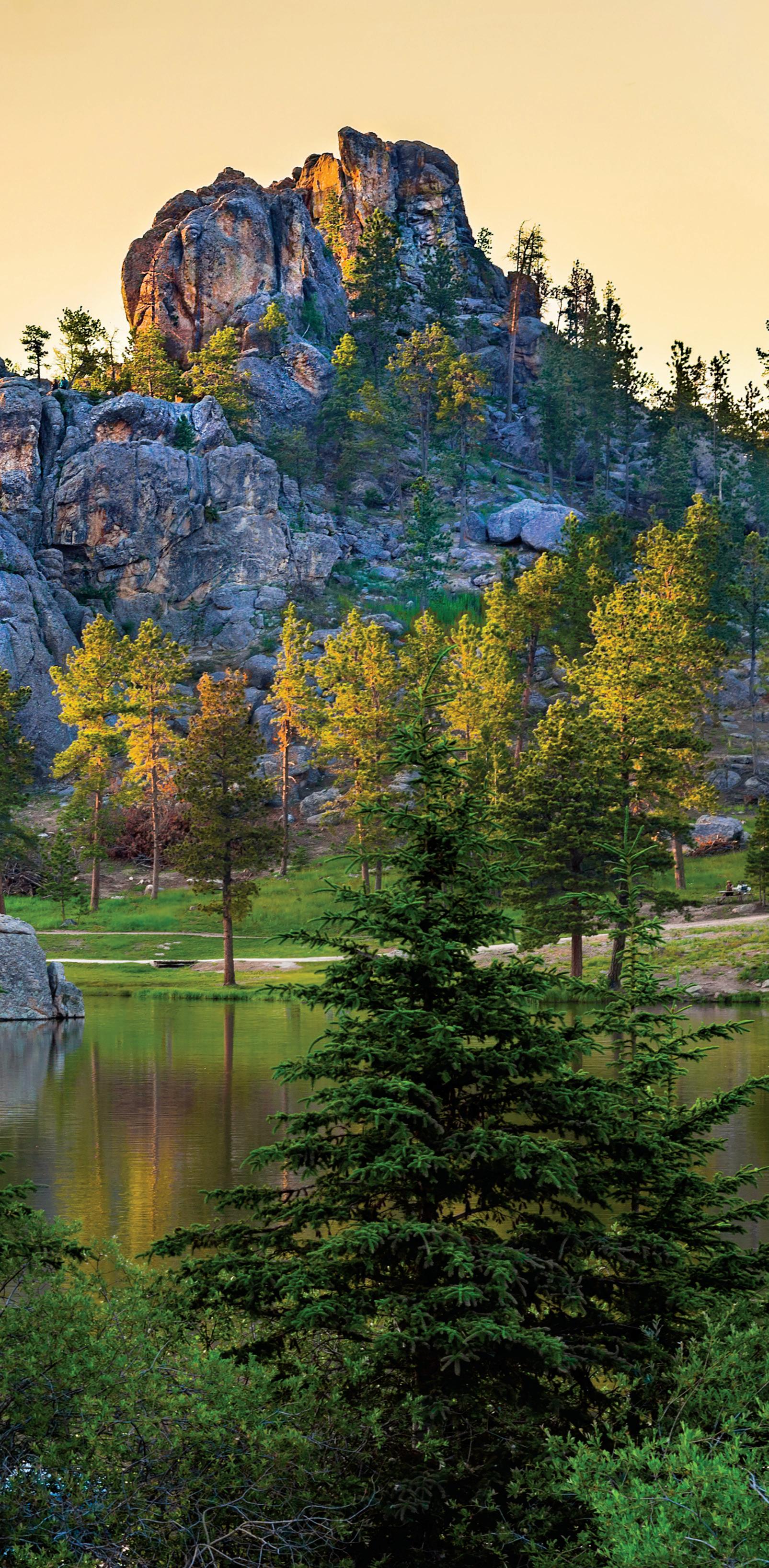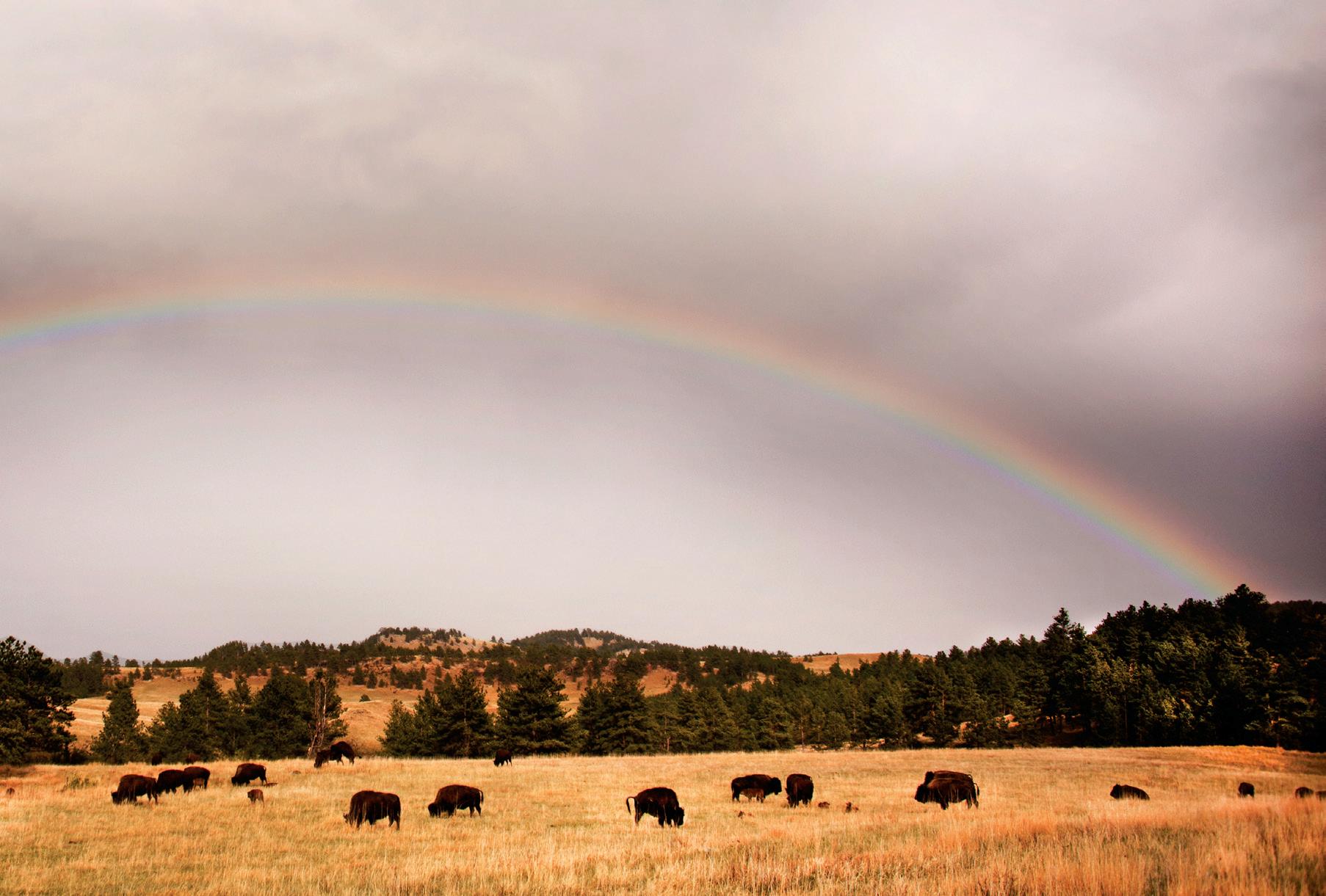
8 minute read
The Black Hills Something More Valuable Than Gold
from LAND Summer 2023
The Black Hills Something More Valuable Than Gold
STORY BY LORIE A. WOODWARD
In the late 1800s, South Dakota’s Black Hills lured fortune seekers with the promise of gold. Today, modern pioneers who explore their recesses are discovering something more valuable—an exceptional quality of life.

"After COVID, quality of life is America’s new gold standard,” said Faith Lewis, broker/owner of Lewis Realty-Keller Williams Black Hills based in Custer, South Dakota. “As a result, the Black Hills are no longer America’s most well-kept secret.”
According to the 2021 National Movers Study, the Black Hills were the No. 2 destination in the nation for relocation. In addition to the region’s natural beauty and Western lifestyle, a robust economy, state government’s common-sense approach to regulation and no state income tax, make South Dakota an appealing place to stake a claim.
With Lewis’ help, Steve and Yolanda Davis, globetrotting Navy veterans and software entrepreneurs who lived in California for 40 years, put down new roots in Custer in March 2021. In recent years, the couple, who met in 1974 when Yolanda was Steve’s boss at his first duty station in Guam, had been unhappy with the changes they were experiencing in California. They had begun considering relocating as early as 2017, but the pandemic’s arrival prompted them to quit considering it and act.
As the regulatory net tightened in California, the Davises left the Golden State and made a beeline to the Black Hills, a long-time favorite destination. Steve had been to all 50 states, but Yolanda missed the trip to Alaska, so she’s just seen 49. Together they have explored 18 foreign countries and three U.S. territories.
“When we sold our company in 2001, we traveled as a hobby and raced cars,” Steve said. “As we crisscrossed the country racing, we always made it a point to stop and stay in the Black Hills.”
He recalled that on those trips through South Dakota, they parked their trailer containing their highvalue equipment and didn’t worry about its security. They also were taken by the resident’s openness, inclusivity and friendliness.
“You can be the third person standing in line at the coffee shop behind two strangers and by the time you get your coffee, you’ll be best friends with the two people standing in front of you,” Steve said, laughing.
Yolanda continued, “Tolerance isn’t just a word that people shout, it’s something they live. Everyone is open to kindness.”
Steve added, “People do their own thing, but they take responsibility for their own actions.”
And because of the local attractions such as Mount Rushmore, people come from all over the globe. During the tourist season, it has a decidedly international flavor that adds another element of interest to life.
The Davises rode out the pandemic at the Dakota Dream Bed and Breakfast and Horse Hotel (www.dakotadreambandb.com) just outside of Custer. They became fast friends with the owner and embraced the lifestyle inherent in the area. The region is dotted with man-made lakes for fishing and paddling, rock outcrops for climbing and trails for ATVs, hiking, biking, and horseback riding.
“I’ve hiked and camped all over the country,” Steve said. “Custer State Park and the Black Hills National Forest are as beautiful as any in the country.”
Yolanda added, “But unlike a lot of other places, it’s not crowded. You’re just minutes from everywhere and it’s not a hassle to get there.”
Steve concluded, “There’s just so much to do here you can’t be bored.”
In mid-2020, the Davises decided to call South Dakota home permanently. After four months of hoop jumping further complicated by COVID, they listed their California home that was located on a secluded beachfront between Big Sur and Carmel.
When they left Custer in June to oversee the sale and prepare to move, there were 84 properties for sale in Custer County. By the time they closed in September and headed north, the number had dropped to eight. A few days later, only three remained—and they, by the Davises’ estimation, were all teardowns.
Then, they experienced the power of community firsthand. The owner of the B&B remembered her neighbor had been interested in selling his property a few years earlier. She introduced them. A deal was struck, but the 85-year-old homeowner asked that they wait to take possession of his house until the following spring, so he wouldn’t have to move during the winter.
The Davises rented a cabin at the Dakota Dream, became part of the community and weathered their first winter. The temperatures can be frigid, but the skies are sunny and the humidity is low.
“In Ohio where I grew up, the winter skies were gray and gloomy for months and the cold was bone-chilling and wet,” Steve said. “Here it might be 8° or 9°F but the sun is blazing and I’ll be outside working.”
Yolanda laughed and said, “It’s amazing what a good pair of thermals does.”
During that winter, they participated in their first-ever Burning of the Pine Beetle. It is an annual event where the community gathers to burn an effigy of a pest that wreaked havoc on the forestry industry throughout the West.
More than 300 people braved the January night to carry flaming torches as part of a meandering procession. Once the ceremonial burning was complete, the townspeople gathered for dinner and dancing at a local watering hole. Laughter and music filled the air. The Aurora Borealis colored the midnight blue velvet sky that was resplendent with stars.
“There’s a spirit and freedom here that is hard to describe,” Steve said. “The people work hard, but they savor life and live it on their own terms. It’s just special.”
In March 2021, the Davises moved into their new home. Their piece of Black Hills heaven encompasses 25 acres dotted by stunning outcrops. White-tailed and mule deer are frequent visitors as are wild turkeys. The stocked pond provides fishing and habitat for waterfowl. Currently, a pair of wild geese are raising their goslings on the property and a group of mallards have taken up temporary residence.
If that’s not enough wild action, the Davises drive four miles to Custer State Park and take a spin around the wildlife loop. They regularly see bison, elk and burros and occasionally spot more elusive species like coyotes and mountain lions.
For the Davises, wildlife has been part of their daily life for decades. At their home in California, sea lions flopped up on the beach and whales swam by 100 yards from the water’s edge. Sea birds squawked, flapped and dove as the ever-changing waves of the Pacific Ocean rushed against the shore. Majesty unfurled in every direction.
“For more than 40 years, we lived in what is literally one of the most beautiful places on the planet,” Steve said. “If the Black Hills beats that, it beats anything.”

THE BLACK HILLS AT A GLANCE
The Black Hills, located in western South Dakota and eastern Wyoming, covers an area 110 miles long and 70 miles wide.
From the vast plains, the namesake hills appear black-green, prompting members of the Lakota tribe to dub them Pahá Sápa, which translates into Black Hills. Black Elk Peak, which rises to 7,242 feet is the highest point between the Rocky Mountains and the Swiss Alps.
While fewer than 240,000 people live here, the small region is home to large living.
Natural Playgrounds
With more than 1.2 million acres of public land to enjoy, it’s an outdoor enthusiast’s paradise. U.S. Forest Service roads and abandoned mining railroad tracks provide almost unlimited opportunities for ATV riding, mountain biking, hiking or horseback riding. For water lovers, the lakes in the hills provide unlimited chances to kayak, canoe, boat and cast a line.
Abundant wildlife means abundant hunting. Granite and limestone outcrops invite rock climbers to test their mettle. In the winter, the northern hills offer skiing, snowshoeing, cross-country skiing, snowmobiling and ice fishing in the frozen lakes.
Famous Landmarks
Visitors from all over the globe come to experience the region’s most famous landmarks: the Mount Rushmore National Memorial and the Crazy Horse Memorial. While they are here, they can’t help but explore the grandeur of Custer State Park, Jewel Cave and Wind Cave national parks, which showcase the world’s third longest and seventh longest caves respectively, and the Devil’s Tower National Monument.
“Banana Belt” Winters
Although Black Hills winters can’t be characterized as mild, the region often enjoys temperature inversions that make the hills sunnier and warmer than in the lower elevations, earning the nickname, the “Banana Belt.” The region has less snow than Denver, warmer winters than Minneapolis and more sunny days than Miami.
Character-filled Communities
Communities through the region including Deadwood, Custer, Sturgis (home of the famous motorcycle rally) and Hot Springs have maintained their unique character and Western-style charm. Rapid City, with a population of 75,000, is the Black Hills’ version of a metropolis. Strangers smile, speak and leave as friends.










